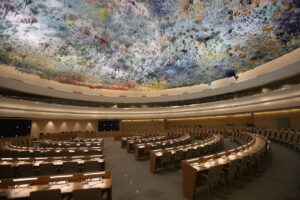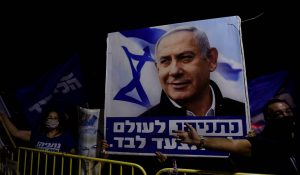As part of UNA-UK’s work campaigning to address the legacy of harm associated with the UK’s nuclear testing, we are delighted to share the first in a series of blogs from Dr Becky Alexis-Martin, who is currently undertaking research on understanding and addressing atomic epistemic injustice in Kiritimati.
Blog by Dr Becky Alexis-Martin, Peace and International Development, University of Bradford
Kiritimati is the largest coral atoll on Earth. Rainbow corals graze azure skies in this startlingly beautiful water world. The island landscape is etched by hundreds of aquamarine pools and girdled by a network of sandy paths that are just wide enough for an intrepid motorcyclist to explore. Within these warm lagoons are thousands of shimmering bonefish, silver trevally, and sailfish. The cries of seabirds echo across the island while tiny crimson and royal blue land crabs scuttle within the undergrowth of the salt bush. The island’s tropical environment and unique ecosystem draw plucky anglers and birdwatchers from around the globe. Kiritimati’s burgeoning tourism sector aspires to attract military heritage tourism and ecotourism in the future.
The island is in a state of accelerated development. Since I was last here in 2018, a small shopping precinct and a large trade store called “Bettys” have opened in Tabwakea – the island’s largest settlement. A new glass-fronted building on the island sits almost empty near the port in Ronton. Locals tell me that it remains untenanted due to high rental costs, but that the community hope that foreign investors will change this situation. The former state hotel is being redeveloped and there are further plans for a new exclusive resort on the island. At dusk, the silhouettes of Chinese fishing boats remodel the Pacific skyline.
It is hard to imagine colossal thermonuclear weapons being detonated here. Yet between 1957 and 1962 the UK and USA undertook 30 airburst tests above Kiritimati, and a further 3 on a neighbouring island in the archipelago, while these territories were under British colonial control. Bomb after bomb exploded in the skies. Operation Grapple demonstrated the UK’s new-found technological prowess to the world. Operation Dominic cemented the British-American special relationship that was produced by the 1958 Mutual Defence Agreement. Shockingly, the local community remained on the small island throughout both test series.
My previous collaborative research has demonstrated that historical militarisation and nuclear weapons testing has produced long-term cultural, humanitarian, and environmental impacts to Kiritimati. The local community was provided with no insight into the motivations for military nuclear weapons testing on their precious land and still struggle with its consequences. While some islanders describe how they were instructed by military personnel in I-Kiribati to leave their homes and take shelter – others can only tell stories of how frightened they were in the moment of the blast. Elders described how their friends lost their hearing or sight, and how some babies were born with birth defects afterwards. No one has received compensation or an apology.
Environmental issues threaten the beauty of Kiritimati. Fly tipping persists across the island despite the possibility of fines, and domestic waste is left to rust and decay in heaps behind villages. The island has no reliable recycling, disposal, or waste shipping facilities. Groundwater issues have been amplified by the climate crisis. Yellowing palm trees are the canary in the coal mine, as saltwater intrusion shrinks the freshwater lens beneath the island and disturbs historical military petrochemical and NAPL residues. Severe weather has become more frequent – and flash flooding leaves the roads pockmarked with potholes. Tabwakea has several power and water outages a week.
The last traces of military encampment are still made visible by the hunks of concrete strewn across the island. These spaces are not preserved or destroyed, but just linger, as though waiting for something to happen. A large desert of scorched coral persists to the South of the island. A gigantic concrete and steel shackle lurks in the saltbush long after it tethered an H-bomb (hanging from an air balloon) to Earth. The coralline ruins of an old military chapel glint in the sunset.
Kiritimati’s tourism manager, Ereti Tekabaia, told me “we want to preserve our nuclear weapons heritage sites for our children and our children’s children. To do this, we need to understand exactly what happened across our island during nuclear weapon testing and to protect sites such as Aeon Field and the coral blast site for the future. We deserve an anti-nuclear museum”.
My research collaboration with ICAN, Article 36, and UNA-UK aims to support community autonomy by facilitating epistemic justice – which is justice of knowledge. At time of writing, I have worked with the community to provide bilingual community co-education and training on the most up to date literature relating to the Treaty on the Prohibition of Nuclear Weapons (TPNW). I have run a series of participatory community workshops with over 175 people – to learn how they would prefer to engage with policymakers and what they might want from a community trust fund. Our TPNW workshops have equipped the local government and community with the skills to understand UN policy, and hopefully, to feel empowered to engage with NGOs and the UN. I have provided education packs that support future community engagement with the Treaty. I have undertaken an interview series that has helped to identify community knowledge baselines and assumptions about the nuclear issues that affect their island. These interviews have shown that there is extremely limited understanding among younger people – and highlights that older people who have lived through the nuclear weapons tests should not have to be the sole ambassadors of the island’s dark past. Something beyond oral storytelling is needed to support the community to preserve their histories.
I am listening to what the community has told me – and the parallels and divergences with existing approaches relating to remediation are becoming clear. The project will hopefully give nuclear communities internationally more autonomy by facilitating their voices and providing a simple way to develop their own knowledge and contacts across disarmament organisations. A community contact database also ensures that community details are securely maintained by relevant organisations to support future policy facilitation and information sharing.
The community have described their vision for Kiritimati during our interviews and epistemic justice workshops. They have talked about how they want community-led and grassroots projects that allow the island to flourish after nuclear weapons testing, and to become resilient in the face of climate crisis. They want grant application training and support throughout the life of projects. They want more information about UN treaties and project to be available in Kiritimati – and for someone local who is part of the community to represent them on the island. They want to facilitate environmental remediation and management, ecosystem development, landscape restoration, heritage protection, cultural preservation, and support for elders and families affected by the nuclear weapon tests.
Generating community understanding of the TPNW has been universally acknowledged as a good idea by everyone from the Victims Association to Ambassador Tito, who was previous President of the Republic of Kiribati, and who is leading the TPNW programme of work for Kiribati. I look forward to building upon the knowledge framework that we have produced together.
Biography
Dr Becky Alexis-Martin is a pacifist academic. Her work explores nuclear warfare, social justice, humanitarian and environmental issues, and human rights. She has authored more than sixty-five news articles, book chapters, and peer-reviewed articles on peace, conflict, and nuclear issues. Her first book, “Disarming Doomsday: The Human Impact of Nuclear Weapons Since Hiroshima”, critically considers the social, cultural, and spatial inequalities and harms perpetuated by nuclear warfare and was the recipient of the 2020 L.H.M. Ling Outstanding First Book Prize.
A note from UNA-UK on the UK’s nuclear testing legacy
UNA-UK urges the UK Government to recognise the rights of all those affected by British nuclear weapons, including indigenous and local peoples affected by testing, production and ongoing related activities. Dr Alexis-Martin’s research makes it clear: the issues raised by the affected communities in Kiribati can be ignored no longer. Now is the time for a national conversation about the legacy of colonial and weapons testing harms.
Recognition of and remediation for this harm British Government remains elusive. Indeed the UK has repeatedly dismissed attempts to discuss nuclear testing impacts through the Treaty on the Non-Proliferation of Nuclear Weapons (NPT) as well as rejecting the Treaty on the Prohibition of Nuclear Weapons (TPNW) which provides a framework to address these harms. We remain hopeful that the UK will adapt its approach.
UNA-UK will be working in parliament, with journalists and with civil society to shine a light on this issue over the coming months.
Read more
- Read more from Dr Alexis-Martin in the UNA-UK and Article 36 report: Addressing British nuclear tests in Kiribati
- See UNA-UK and Article 36 on Kiribati’s joint statement at the 2023 NPT Preparatory Committee
- Read the Joint Statement on behalf of Kiribati and Kazakhstan at the 2023 NPT Preparatory Committee General Debate
Photo: The threatened lagoonal environment of Kiritimati. Credit: Dr Becky Alexis-Martin.
https://una.org.uk/news/generating-atomic-epistemic-justice-kiritimati-changing-what-we-dont-know




